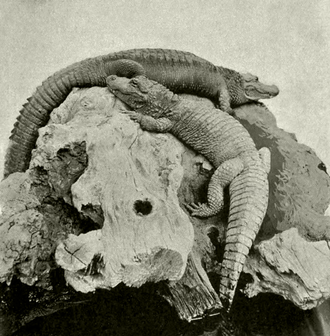An alligator is a large reptile in the Crocodilia order in the genus Alligator of the family Alligatoridae. The two extant species are the American alligator (A. mississippiensis) and the Chinese alligator (A. sinensis). Additionally, several extinct species of alligator are known from fossil remains. Alligators first appeared during the Oligocene epoch about 37 million years ago.
Alligators and caimans split in North America during the early Tertiary or late Cretaceous (about 53 million to about 65 million years ago). The Chinese alligator split from the American alligator about 33 million years ago and likely descended from a lineage that crossed the Bering land bridge during the Neogene. The modern American alligator is well represented in the fossil record of the Pleistocene.[1] The alligator's full mitochondrial genome was sequenced in the 1990s. The full genome, published in 2014, suggests that the alligator evolved much more slowly than mammals and birds.
An average adult American alligator's weight and length is 360 kg (790 lb) and 4 m (13 ft), but they sometimes grow to 4.4 m (14 ft) long and weigh over 450 kg (990 lb).[10] The largest ever recorded, found in Louisiana, measured 5.84 m (19.2 ft).[11] The Chinese alligator is smaller, rarely exceeding 2.1 m (7 ft) in length. Additionally, it weighs considerably less, with males rarely over 45 kg (100 lb).
Adult alligators are black or dark olive-brown with white undersides, while juveniles have bright yellow or whitish stripes which sharply contrast against their dark hides, providing them additional camouflage amongst reeds and wetland grasses.
No average lifespan for an alligator has been measured. One of the oldest recorded alligator lives was that of Saturn, an American alligator who was hatched in 1936 in Mississippi and spent nearly a decade in Germany before spending the majority of its life at the Moscow Zoo, where it died at the age of 83 or 84 on 22 May 2020. Another one of the oldest lives on record is that of Muja, an American alligator who was brought as an adult specimen to the Belgrade Zoo in Serbia from Germany in 1937. Although no valid records exist about its date of birth, as of 2012, it was in its 80s and possibly the oldest alligator living in captivity.
American alligators are found in the southeast United States: all of Florida and Louisiana; the southern parts of Georgia, Alabama, and Mississippi; coastal South and North Carolina; East Texas, the southeast corner of Oklahoma, and the southern tip of Arkansas. Louisiana has the largest alligator population. The majority of American alligators inhabit Florida and Louisiana, with over a million alligators in each state. Southern Florida is the only place where both alligators and crocodiles live side by side. A small population is also found in Tamaulipas, in Mexico.
American alligators live in freshwater environments, such as ponds, marshes, wetlands, rivers, lakes, and swamps, as well as in brackish water. When they construct alligator holes in the wetlands, they increase plant diversity and provide habitat for other animals during droughts. They are, therefore, considered an important species for maintaining ecological diversity in wetlands. Farther west, in Louisiana, heavy grazing by coypu and muskrat are causing severe damage to coastal wetlands. Large alligators feed extensively on coypu, and provide a vital ecological service by reducing coypu numbers.
Large male alligators are solitary territorial animals. Smaller alligators can often be found in large numbers close to each other. The largest of the species (both males and females) defend prime territory; smaller alligators have a higher tolerance for other alligators within a similar size class.
Alligators move on land by two forms of locomotion referred to as "sprawl" and "high walk". The sprawl is a forward movement with the belly making contact with the ground and is used to transition to "high walk" or to slither over wet substrate into water. The high walk is an up-on-four-limbs forward motion used for overland travel with the belly well up from the ground. Alligators have also been observed to rise up and balance on their hind legs and semi-step forward as part of a forward or upward lunge. However, they can not walk on their hind legs.
Although the alligator has a heavy body and a slow metabolism, it is capable of short bursts of speed, especially in very short lunges. Alligators' main prey are smaller animals they can kill and eat with a single bite. They may kill larger prey by grabbing it and dragging it into the water to drown. Alligators consume food that cannot be eaten in one bite by allowing it to rot or by biting and then performing a "death roll", spinning or convulsing wildly until bite-sized chunks are torn off. Critical to the alligator's ability to initiate a death roll, the tail must flex to a significant angle relative to its body. An alligator with an immobilized tail cannot perform a death roll.
Most of the muscle in an alligator's jaw evolved to bite and grip prey. The muscles that close the jaws are powerful, but the muscles for opening their jaws are weak. As a result, an adult human can hold an alligator's jaws shut bare-handed. It is common to use several wraps of duct tape to prevent an adult alligator from opening its jaws when being handled or transported.
